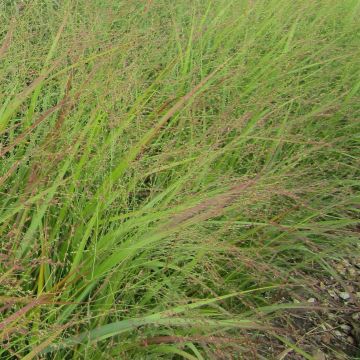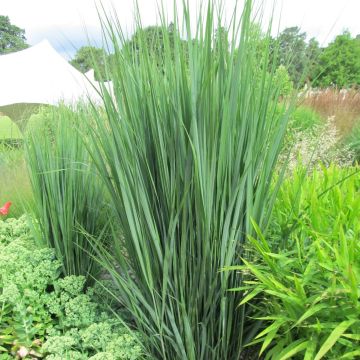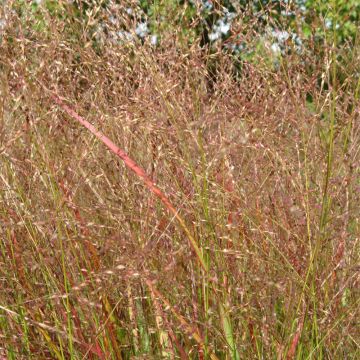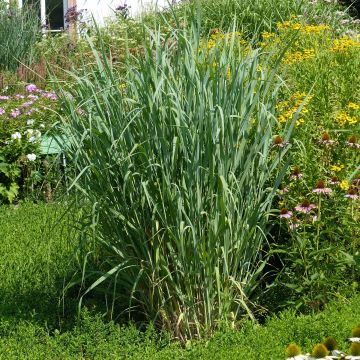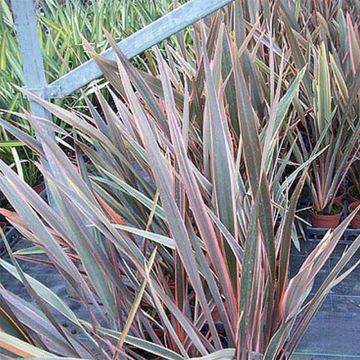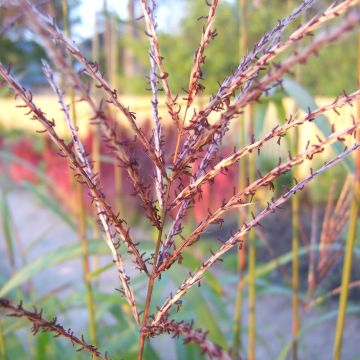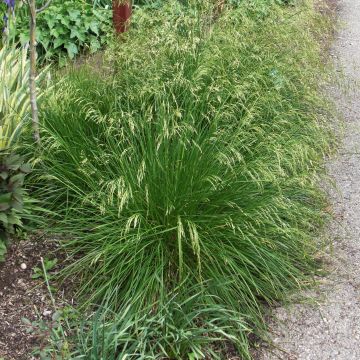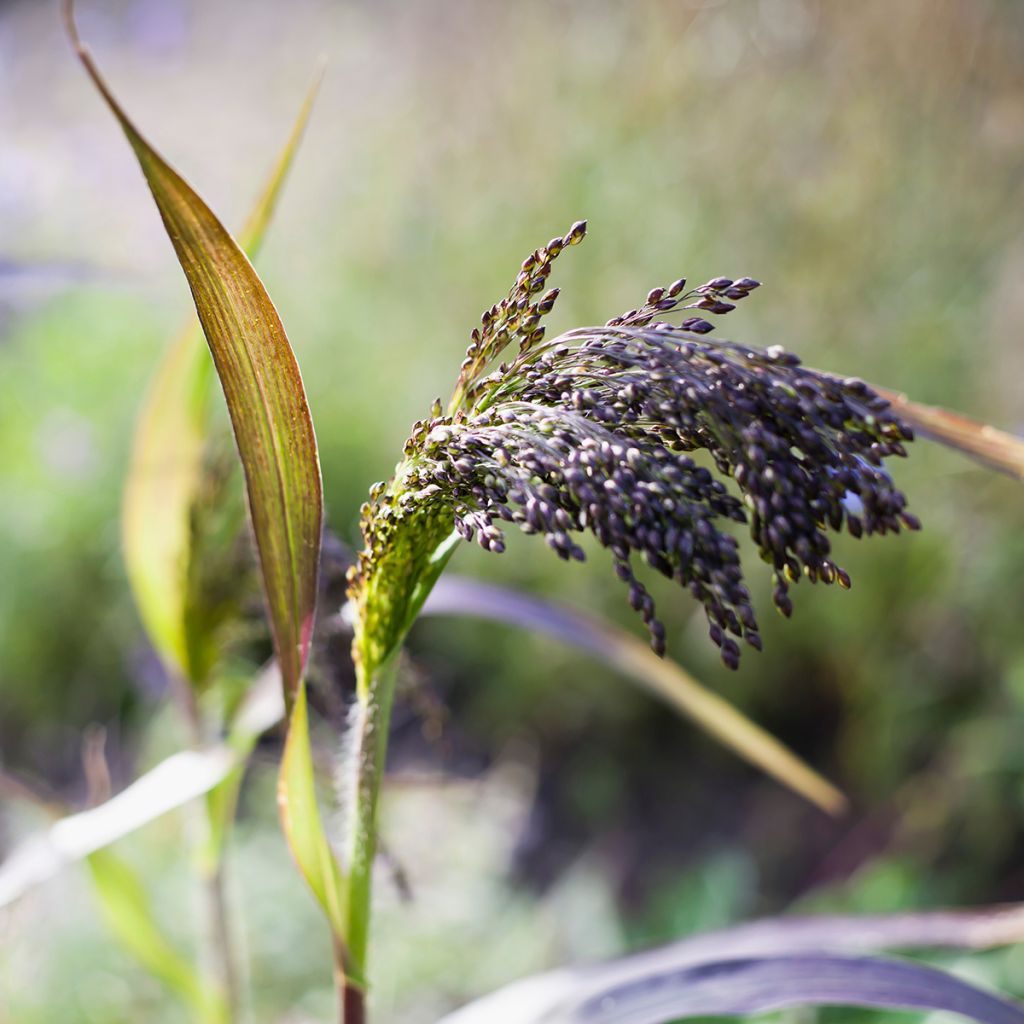

Panicum miliaceum Violaceum - seeds
Panicum miliaceum Violaceum - seeds
Panicum miliaceum Violaceum
Proso Millet, Broomcorn Millet, Common Millet, Hog Millet, White Millet
Home or relay delivery (depending on size and destination)
Schedule delivery date,
and select date in basket
This plant carries a 6 months recovery warranty
More information
We guarantee the quality of our plants for a full growing cycle, and will replace at our expense any plant that fails to recover under normal climatic and planting conditions.
Does this plant fit my garden?
Set up your Plantfit profile →
Description
The Common Violet Millet is a beautiful form with violet flowering of Panicum miliaceum, an annual grass cultivated as a secondary cereal for its edible seeds. The plant has upright stems with narrow, fairly dark green leaves. The 'Violaceum' variety is interesting for its large trailing violet or purple panicles in late summer. This grass likes the sun, but has very few soil and watering requirements. It finds its place in wild, natural or contemporary style gardens.
The common millet is an annual herbaceous plant in the Poaceae family, like many grasses. Cultivated since prehistoric times, it is probably native to India and temperate Asia. It is a particularly low-maintenance "cereal", probably one of the least water-demanding. This plant grows in clumps of leafy stems that fan out like a fountain. When mature, it reaches a height of about 90 cm (35in), sometimes up to 1.20 m (4ft) depending on growing conditions. Its base produces upright, rough, woody and hairy stems, adorned with long narrow, dark green leaves. Flowering occurs more or less early in summer, depending on the sowing date. The inflorescence is a fairly dense, highly branched, trailing panicle that can reach 30 cm (12in) in length. After wind pollination, small seeds enveloped in a violet film form. They are dispersed by the wind and ensure the plant's perpetuity, both in the garden and in nature.
The Common 'Violet' Millet can be grown in any fresh and well-drained soil. This grass is appreciated for its beautiful decorative inflorescences. Just like Sorghum, it accompanies perennial and light annual plants, such as toadflaxes, penstemons, field daisies, Aster cordifolius etc. Plant it with all the right cut flowers (dahlias, amaranths, large-flowered roses) to create beautiful bouquets. Also consider pairing it with Briza Media for the grace of its spikelets in floral compositions.
In the Kitchen:
The violet millet panicles should be harvested when the seeds are dark purple in colour. When cooked, they can be used as a side cereal, in pastries, or added to salads, soups, and desserts. They are also used in the diet of poultry and wild birds.
Common millet is gluten-free. The grains, along with their husks, are rich in dietary fibre and B-group vitamins. They also contain minerals such as manganese, zinc, magnesium, phosphorus, and iron.
Report an error about the product description
Flowering
Foliage
Plant habit
Botanical data
Panicum
miliaceum
Violaceum
Poaceae
Proso Millet, Broomcorn Millet, Common Millet, Hog Millet, White Millet
West Asia
Other Panicum
View all →Planting and care
Sow directly into the open ground after the last frost, when the soil has warmed up, from April to the end of May depending on the regions.
Choose a sunny location with well-drained soil, free from weeds. Improve the soil by adding compost, refined soil or organic fertiliser.
Sow the seeds at a depth of about 1 to 2 centimetres (0 to 1 inches), spacing them about 15 to 20 centimetres (6 to 8 inches) apart. Keep the soil moist during the germination period. Water regularly, making sure not to overwater the soil to avoid seed rot. Once the plants have developed their roots, they tolerate periods of moderate water scarcity.
Regularly remove weeds around the plants and monitor for possible pest infestations.
Sowing period
Intended location
This item has not been reviewed yet - be the first to leave a review about it.
Similar products
Haven't found what you were looking for?
Hardiness is the lowest winter temperature a plant can endure without suffering serious damage or even dying. However, hardiness is affected by location (a sheltered area, such as a patio), protection (winter cover) and soil type (hardiness is improved by well-drained soil).

Photo Sharing Terms & Conditions
In order to encourage gardeners to interact and share their experiences, Promesse de fleurs offers various media enabling content to be uploaded onto its Site - in particular via the ‘Photo sharing’ module.
The User agrees to refrain from:
- Posting any content that is illegal, prejudicial, insulting, racist, inciteful to hatred, revisionist, contrary to public decency, that infringes on privacy or on the privacy rights of third parties, in particular the publicity rights of persons and goods, intellectual property rights, or the right to privacy.
- Submitting content on behalf of a third party;
- Impersonate the identity of a third party and/or publish any personal information about a third party;
In general, the User undertakes to refrain from any unethical behaviour.
All Content (in particular text, comments, files, images, photos, videos, creative works, etc.), which may be subject to property or intellectual property rights, image or other private rights, shall remain the property of the User, subject to the limited rights granted by the terms of the licence granted by Promesse de fleurs as stated below. Users are at liberty to publish or not to publish such Content on the Site, notably via the ‘Photo Sharing’ facility, and accept that this Content shall be made public and freely accessible, notably on the Internet.
Users further acknowledge, undertake to have ,and guarantee that they hold all necessary rights and permissions to publish such material on the Site, in particular with regard to the legislation in force pertaining to any privacy, property, intellectual property, image, or contractual rights, or rights of any other nature. By publishing such Content on the Site, Users acknowledge accepting full liability as publishers of the Content within the meaning of the law, and grant Promesse de fleurs, free of charge, an inclusive, worldwide licence for the said Content for the entire duration of its publication, including all reproduction, representation, up/downloading, displaying, performing, transmission, and storage rights.
Users also grant permission for their name to be linked to the Content and accept that this link may not always be made available.
By engaging in posting material, Users consent to their Content becoming automatically accessible on the Internet, in particular on other sites and/or blogs and/or web pages of the Promesse de fleurs site, including in particular social pages and the Promesse de fleurs catalogue.
Users may secure the removal of entrusted content free of charge by issuing a simple request via our contact form.
The flowering period indicated on our website applies to countries and regions located in USDA zone 8 (France, the United Kingdom, Ireland, the Netherlands, etc.)
It will vary according to where you live:
- In zones 9 to 10 (Italy, Spain, Greece, etc.), flowering will occur about 2 to 4 weeks earlier.
- In zones 6 to 7 (Germany, Poland, Slovenia, and lower mountainous regions), flowering will be delayed by 2 to 3 weeks.
- In zone 5 (Central Europe, Scandinavia), blooming will be delayed by 3 to 5 weeks.
In temperate climates, pruning of spring-flowering shrubs (forsythia, spireas, etc.) should be done just after flowering.
Pruning of summer-flowering shrubs (Indian Lilac, Perovskia, etc.) can be done in winter or spring.
In cold regions as well as with frost-sensitive plants, avoid pruning too early when severe frosts may still occur.
The planting period indicated on our website applies to countries and regions located in USDA zone 8 (France, United Kingdom, Ireland, Netherlands).
It will vary according to where you live:
- In Mediterranean zones (Marseille, Madrid, Milan, etc.), autumn and winter are the best planting periods.
- In continental zones (Strasbourg, Munich, Vienna, etc.), delay planting by 2 to 3 weeks in spring and bring it forward by 2 to 4 weeks in autumn.
- In mountainous regions (the Alps, Pyrenees, Carpathians, etc.), it is best to plant in late spring (May-June) or late summer (August-September).
The harvesting period indicated on our website applies to countries and regions in USDA zone 8 (France, England, Ireland, the Netherlands).
In colder areas (Scandinavia, Poland, Austria...) fruit and vegetable harvests are likely to be delayed by 3-4 weeks.
In warmer areas (Italy, Spain, Greece, etc.), harvesting will probably take place earlier, depending on weather conditions.
The sowing periods indicated on our website apply to countries and regions within USDA Zone 8 (France, UK, Ireland, Netherlands).
In colder areas (Scandinavia, Poland, Austria...), delay any outdoor sowing by 3-4 weeks, or sow under glass.
In warmer climes (Italy, Spain, Greece, etc.), bring outdoor sowing forward by a few weeks.






































